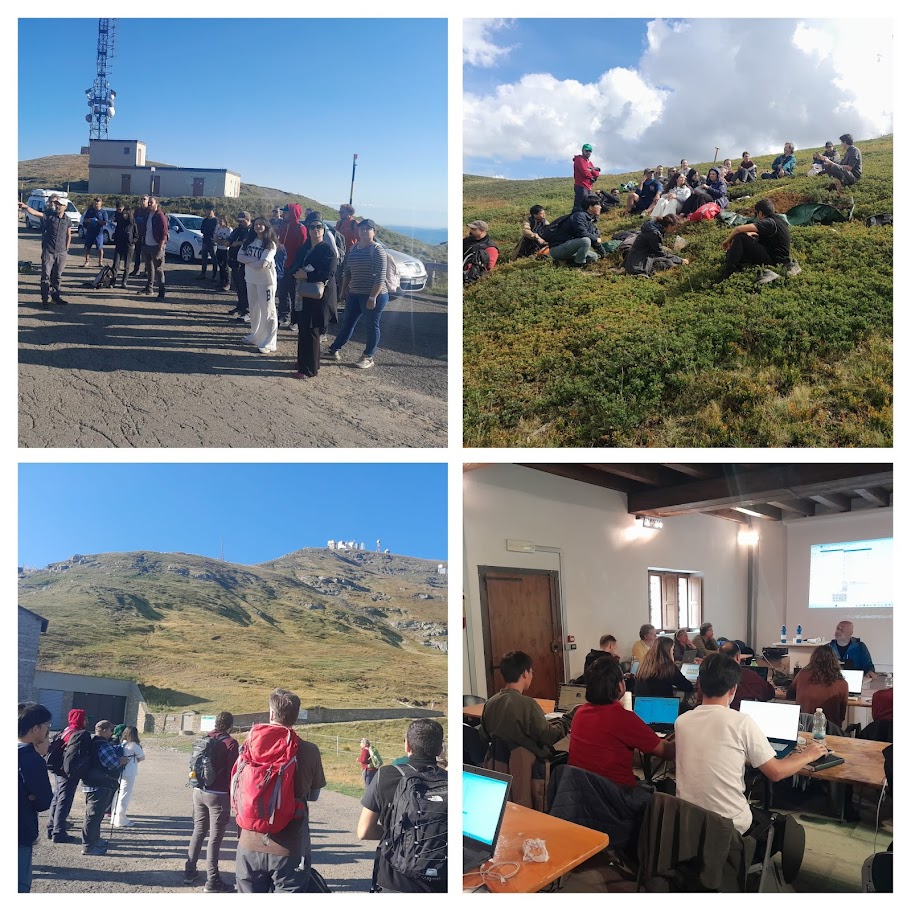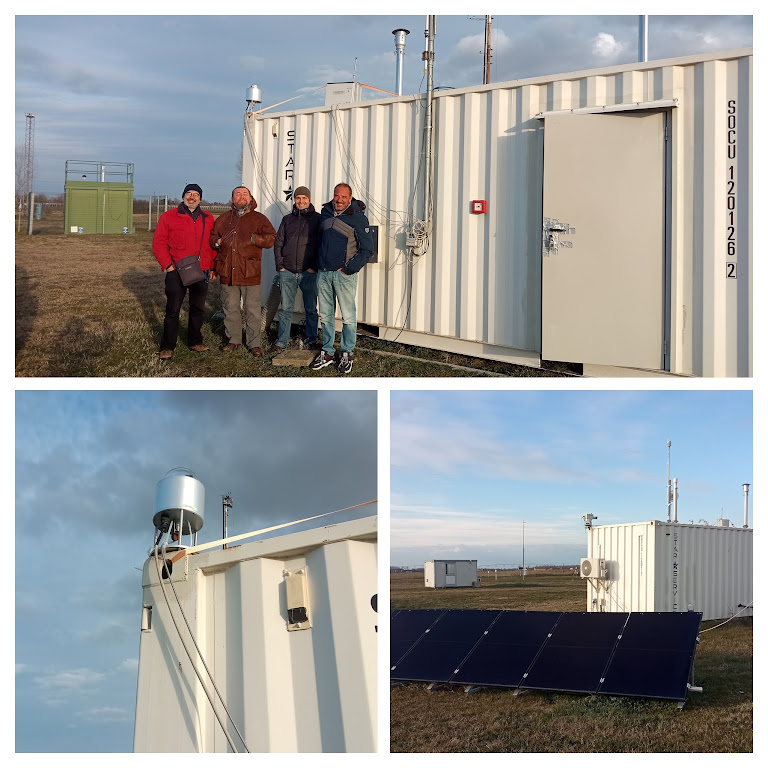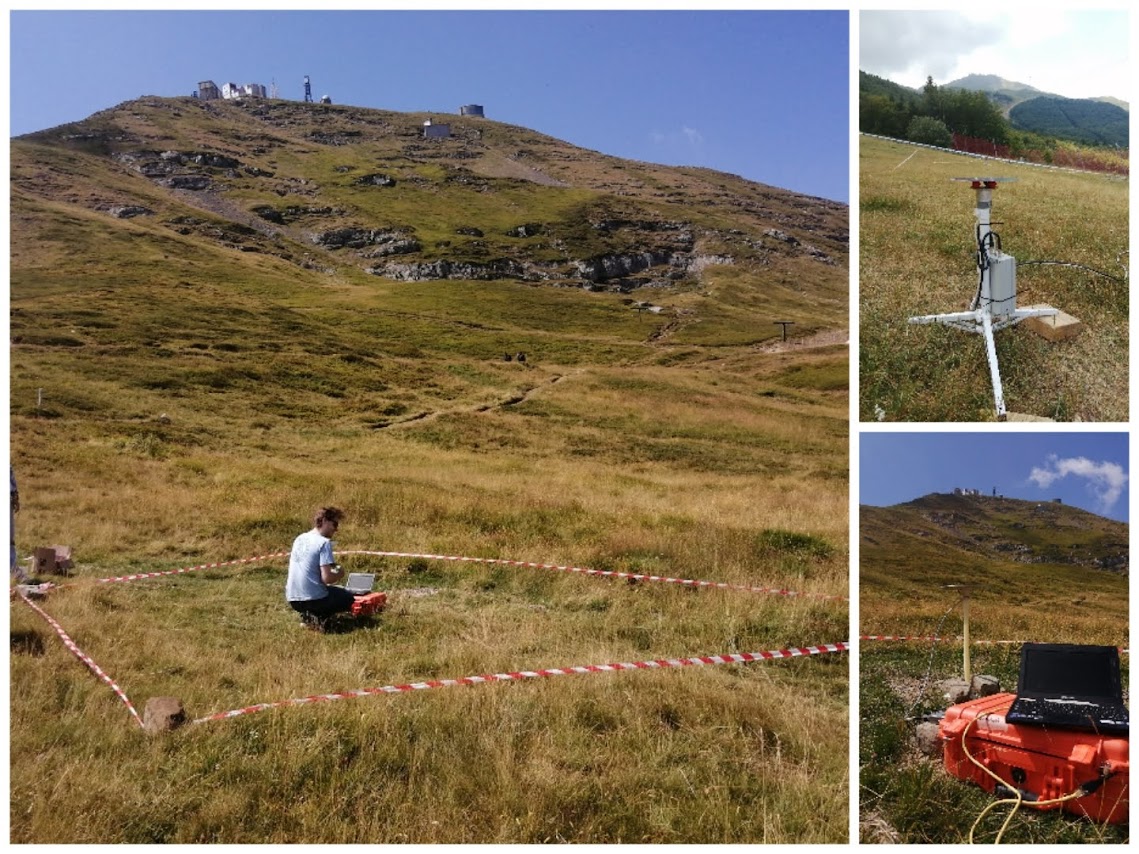TNA Experiences
In the following you can find examples of recent TNA projects hosted at the CMN-PV facility.
Molecular Composition of Clouds at mt. Cimone (MC3)
Clouds are an important missing piece in the climate change puzzle: they are likely to play a pivotal role, but major uncertainties still exist on their formation, composition and transformation. Atmospheric particles and gases dissolve into cloud droplets, where they are transformed by chemical, photochemical and biological processes. Afterwards, cloud can precipitate as rain or, if water evaporates, release transformed gases and particles into the atmosphere, thus impacting climate and air quality.

Cloud water (CW) is a highly effective reactive medium, promoting chemical transformations that would not occur in the gas phase or often with a much lower reaction rate. Moreover, microorganisms, such as bacteria, fungi and yeasts, have been detected in clouds. Research studies show that the majority of microorganisms in CW are alive and metabolically active and may alter the chemical composition of droplets and lead, consequently, to a potential variation of the CCN activity of the aerosol released after cloud evaporation.
One aim of MC3 was to collect samples at CMN during October to investigate their chemical and microbiological composition. The analysis of the samples revealed 3 sampling periods: (1) October 07-10, with air masses mainly originating from Spain with a majority of Cl− and Na+ that are characteristics of marine origin; period (2) October 16-18 with air masses originating from North of Africa, impacted by a Saharan dust event with a high concentration in Ca2+; period (3) October 22-23 marked by air masses originated from southern Italy under polluted influence with a high concentration in NO3−. The analysis of the molecular composition of dissolved organic matter by high resolution mass spectrometry and the comparison of these results with those obtained for other mountain sites (Maïdo mountain and puy de Dôme, France) will give additional insight on the impact of sources and environmental conditions.
"Monte Cimone is an ideal observatory for cloud studies: the high cloud occurrence and the limited impact of local sources is particularly interesting. Moreover, air masses coming from the Po valley are frequently observed and make this site unique, at least in Europe. The support of the scientific and technical team was amazing and we really enjoyed our stay. we sincerely hope that the collaboration will go beyond the MC3 campaign" - Dr. Angelica Bianco (Université Clermont Auvergne, MC3 PI)
ATMospheric Observations and Soil Organic Carbon (ATMO-SOC)
The ATMO-SOC TNA was a training project designed to provide a user group consisting mainly of soil scientists with basic knowledge of:
- the main processes that determine the variability of CO2, CH4, N2O and NOx in the atmosphere and the feedbacks between climate and changes in the related global cycles;
- the state of the art techniques and methodologies for precise and high quality observations of atmospheric composition that can be directly related to the carbon and nitrogen cycles;
- the usability of these data and their general suitability for purposes;
- how to access regional and global data sets related to observations of CO2, CH4, N2O and NOx.
The ATMO-SOC training was a tailor-made module presented in the framework of the International Summer School "High Mountain Ecosystems by Soil Survey and GIS-based Mapping", held in Sestola (Italy) from 9 to 13 September 2024. The final objective was to promote an integrated use of atmospheric observations with soil science.
The training was provided through two remote seminars and a physical access to the ICOS/ACTRIS atmospheric site at Mt.Cimone (2165 m a.s.l., Italy), part of the CMN-PV facility As being introduced to the world-class CMN-PV atmospheric facility, the user group had the opportunity to gain a basic knowledge of the most advanced techniques for studying atmospheric composition by in-situ measurements, as well as the challenges and the usability of the related data in the context of the nitrogen and carbon cycle.
"Thanks very much for such an excellent workshop. My students learnt a huge amount and enjoyed interacting with the other delegates" - Dr. Paul Hallet, University of Aberdeen.

Measurements Intercomparison for New Spectroscopic Instrument Calibration (MINSPEC)
Nitrogen dioxide (NO2) and ozone (O3) are two of the most studied atmospheric compounds due to their interactions and behaviour depending on the photochemistry and heterogeneous chemical reactions involving these elements. In the stratosphere O3 act as a filter for the harmful UV radiation while at the surface O3 is a strong pollutant and NO2 plays an important role in controlling tropospheric ozone.
Nowadays the trace gases monitoring is performed from many different platforms from different point of view and with different techniques. The satellite systems gives a global coverage of the Earth and in the last years the spatial resolution of the observations increased of about 3 order of magnitude. For obvious reasons, satellite system can only perform remote sensing measurements both in active (lidar) as in passive (imager/spectrometers) modes. Ground-based observations can be performed with ‘in situ’ as well as remote sensing techniques.
The goal of the MINSPEC experiment was to perform NO2 and O3 remote-sensing measurements in the Po basin with a SPATRAM3 (Spectromweter for Atmospheric Tracers Monitoring Rel.3) system and to compare instrument performance with a similar ACTRIS-compliant system working at the CMN-PV facility.
"We decided to access the CMN - PV facility because this facility is one of the most complete laboratory existing in Italy with high-qualified staff with strong expertises in active/passive remote sensing techniques and solar instrumentation" - Dr. Miguel Potes, PI of the MINSPEC project, said. "Moreover, it is located in one of the most polluted region in Europe (i.e. the Po basin) and our measurements can be valuable in terms of scientific exploitation".

Radio Interferometric Characterisation of High Energy Sources from Thunderstorms (RICHEST)
Thunderstorms are the site of the most energetic natural particle accelerators on Earth, capable to accelerate electrons up to several tens of MeV. Acceleration can be impulsive, resulting in submillisecond photon bursts termed Terrestrial Gamma-ray Flashes (TGF), so bright that can be detected from space by satellites hosting gamma-ray detectors. Acceleration can also take place as a quasi-stationary process, resulting in large-scale minute-long Gamma-ray Glows, that can be detected by aircrafts flying in the vicinity of thunderstorms, or by ground-based detectors. Thousands of TGFs have now been detected from space, while detections of TGFs and gamma-ray glows from ground are still sparse and limited to few locations in the world. The goal of the RICHEST project, performed in the framework of the ATMO-ACCESS TNA Program, was to perform dedicated lightning measurements to be run simultaneously with the gamma-ray detection by the National Project GAMMA-FLASH.

“We are an international team joining scientists from Norway, UK, Spain and Italy” – RICHEST Principal Investigator Martino Marisaldi, said. “Our goal was the study of lightning activity near the Mt. Cimone station using radio receivers in a wide range of frequencies, in correlation with an experiment aimed at observing high-energy gamma-rays sometimes produced in thunderstorms. Our experience in the field has been great: the location was perfect, and the logistic support from ISAC personnel, the local Air Force base, and the workers at ‘Consorzio Monte Cimone’ has been highly professional and outstanding. We managed to realize the radio survey of the site, in preparation of further measurements, and we obtained high-quality radio measurements of lightning that we are planning to publish soon.”
Medusa Enhanced Volatile Organic Compounds (MEVOC)
Anthopogenic Non-Methane Volatile Organic Compounds (NM-VOC) are reactive atmospheric species with direct effects on human health and ecosystems. Moreover, through their oxidation products, NM-VOCs promote the formation of tropospheric ozone and secondary aerosol, which are important pollutants but also anthropogenic climate forcers. In Europe, only 4 observatories are performing continuous observations of these important species with the accuracy and traceability needed for long-term monitoring of their atmospheric levels and for emission trend assessment. For almost 20 years, an instrument to continuously monitor 15 NM-VOCs has operated at the CMN-PV facility: the sampling location, which overlooks an important source region in the Po basin and is the Southernmost NM-VOC monitoring site in Europe, is crucial for tracking and quantifying emissions of these compounds at regional scale.
Within MEVOC, a team composed by University of Bristol and Terramodus private company, installed a "Medusa" GCMS preconcentration system at CMN-PV to enhance the previously existing instrumentation and make observations at CMN-PV consistent with other European stations. Optimisation of this specialist equipment was undertaken and training of the local operators conducted. The increased number of observed species and improved precision from the Medusa GCMS is useful for NM-VOC regulations as well as other international regulations such as the Paris Agreement.
Propane atmospheric mixing ratio (upper plot measured in ppt) and instrument precision (lower plot in %) measured by the new Medusa (blue) and the older ADS (red) system at Monte Cimone under MEVOC Project.
Example of Past Scientific Results (last 10 years)
Here you can find a selection of some of the most important scientific results obtained by the contribution of the atmospheric experimental activities carried out at the M. Cimone – Po valley facility in the last 10 years.
-
Cai, J., Sulo, J., Gu, Y., Holm, S., Cai, R., Thomas, S., Neuberger, A., Mattsson, F., Paglione, M., Decesari, S., Rinaldi, M., Yin, R., Aliaga, D., Huang, W., Li, Y., Gramlich, Y., Ciarelli, G., Quéléver, L., Sarnela, N., Lehtipalo, K., Zannoni, N., Wu, C., Nie, W., Mohr, C., Kulmala, M., Zha, Q., Stolzenburg, D., and Bianchi, F.: Elucidating the mechanisms of atmospheric new particle formation in the highly polluted Po Valley, Italy, EGUsphere [preprint], https://doi.org/10.5194/egusphere-2023-1803, 2023.
-
Fratticioli C, al et. Continuous atmospheric in-situ measurements of the CH4/CO ratio at the Mt. Cimone station (Italy, 2165 m a.s.l.) and their possible use for estimating regional CH4 emissions. Environ. Res . 2023;232. doi:10.1016/j.envres.2023.116343
-
Putero D, al. et. Fingerprints of the COVID-19 economic downturn and recovery on ozone anomalies at high-elevation sites in North America and western Europe. Atmos. Chem. Phys. 2023;23. doi:10.5194/acp-23-15693-2023
-
Cristofanelli P, al. et. Negative ozone anomalies at a high mountain site in northern Italy during 2020: a possible role of COVID-19 lockdowns?. Environmental Research Letters 2021. doi:https://doi.org/10.1088/1748-9326/ac0b6a
-
Vollmer MK et al. Unexpected nascent atmospheric emissions of three ozone-depleting hydrochlorofluorocarbons. PNAS 2021;118(5). doi:https://doi.org/10.1073/pnas.2010914118
- Bhandari J, et al. Extensive soot compaction by cloud processing from laboratory and field observations. Scientific Reports 2019. doi:https://doi.org/10.1038/s41598-019-48143-y.
-
Prinn RG, et al. History of chemically and radiatively important atmospheric gases from the Advanced Global Atmospheric Gases Experiment (AGAGE). Earth System Science Data 2018: 10, 985-1018. https://doi.org/10.5194/essd-10-985-2018
-
Graziosi F, et al. European emissions of the powerful greenhouse gases hydrofluorocarbons inferred from atmospheric measurements and their comparison with annual national reports to UNFCCC. Atmospheric Environment 2017;158. doi:https://doi.org/10.1016/j.atmosenv.2017.03.029
-
Rinaldi M, et al. Atmospheric Ice Nucleating Particle measurements at the high mountain observatory Mt. Cimone (2165~m a.s.l., Italy). Atmospheric Environment 2017;171. doi:https://doi.org/10.1016/j.atmosenv.2017.10.027
-
Graziosi F, et al. Emissions of Carbon Tetrachloride (CCl4) from Europe. Atmospheric Chemistry and Physics 2016; 16, 12849-12859.
-
Duchi R, al et. Long-term (2002-2012) investigation of Saharan dust transport events at Mt. Cimone GAW global station, Italy (2165 m a.s.l.). Elementa Science of Anthropocene 2016;4. doi:https://doi.org/10.12952/journal.elementa.000085
-
Cristofanelli P, et al. Long-term surface ozone variability at Mt. Cimone WMO/GAW global station (2165 m a.s.l., Italy). Atmospheric Environment 2014;101:23-33. doi:https://doi.org/10.1016/j.atmosenv.2014.11.012
- Paasonen P , et al. Warming-induced increase in aerosol number concentration likely to moderate climate change. Nature Geosciences 2013:6, 438-442, 2013.
-
Svenningsson B, et al. Hygroscopic growth and critical supersaturations for mixed aerosol particles of inorganic and organic compounds of atmospheric relevance. Atmospheric Chemistry and Physics 2006. doi:https://doi.org/10.5194/ACP-6-1937-2006
-
Putaud J-P, et al. A European aerosol phenomenology—2: chemical characteristics of particulate matter at kerbside, urban, rural and background sites in Europe. Atmospheric Environment 2004: 38 (16), 2579-2595. https://doi.org/10.1016/j.atmosenv.2004.01.041.